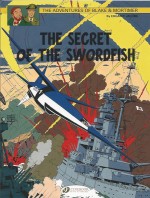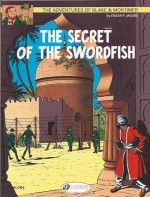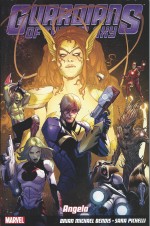
By Edgar P. Jacobs, coloured by Philippe Biermé & Luce Daniels translated by Jerome Saincantin (Cinebook)
ISBN: 978-1-84918-174-7
After three years of stunning intrigue mystery and action, E.P. Jacobs’ groundbreaking saga of a battle for world peace and universal liberty concluded in a spectacular duel below the Earth and in the skies of the embattled world.
The saga concludes in SX1 Strikes Back!: a tension-drenched race against time as
Blake, Mortimer and the shattered dregs of Great Britain’s military forces prepare for a last ditch strike using the Professor’s greatest inventions to win freedom for the oppressed peoples of the world…
Brussels-born Edgar P. Jacobs was a prodigy who drew from an early age and was besotted by music and the performing arts – especially opera. After graduating commercial school in 1919, he rejected safe office work and instead avidly pursued his passions drama on his graduation.
A succession of odd jobs at opera-houses (which included everything from scene-painting to set decoration and even performing as both an acting and singing extra) supplemented private performance studies, and in 1929 Jacobs won an award from the Government for classical singing.
His dream of operatic glory was crushed by the Great Depression, and when arts funding dried up following the global stock market crash he was forced to pick up whatever dramatic work was going, although this did include more singing and performing. He moved into illustration in 1940, with regular work for Bravo magazine and some jobs for short stories and novels, and when the occupying Nazi authorities in Belgium banned Alex Raymond’s quintessentially All-American Hero Flash Gordon Jacobs famously took over the syndicated strip to complete the saga.
His ‘Stormer Gordon’ lasted less than a month before being similarly embargoed by the Occupation dictators, after which the man of many talents simply created his own epic science-fantasy feature in the legendary Le Rayon U, a milestone in both Belgian comics and science fiction adventure.
During this period Jacobs and Tintin creator Hergé got together, and whilst creating the weekly U Ray strip the younger man began assisting on Tintin, colouring the original black and white strips of The Shooting Star (originally run in newspaper Le Soir) for an upcoming album collection.
By 1944 Jacobs was performing similar duties on Tintin in the Congo, Tintin in America, King Ottokar’s Sceptre and The Blue Lotus. He was also contributing to the drawing too, working on the extended epic The Seven Crystal Balls/Prisoners of the Sun.
Following the Liberation, publisher Raymond Leblanc convinced Hergé, Jacobs and a few other comicstrip masters to work for a new venture. Founding publishing house Le Lombard, Leblanc also commissioned Le Journal de Tintin, an anthology comic with editions in Belgium, France and Holland, edited by Herge and starring the intrepid boy reporter plus a host of newer heroes.
Beside Hergé, Jacobs and writer Jacques van Melkebeke, Le Journal de Tintin featured Paul Cuvelier’s ‘Corentin’ and Jacques Laudy’s ‘The Legend of the Four Aymon Brothers’.
Laudy had been a friend of Jacobs’ since their time together on Bravo, and the epic thriller serial ‘Le secret de l’Espadon’ starred an English Military Intelligence officer closely modelled on Laudy, who worked with bluff, gruff British Boffin: Captain Francis Blake and Professor Philip Mortimer…
The premiere serial ran from issue #1 (26th September 1946 to September 8th 1949) and cemented Jacobs’ status as a star in his own right. In 1950, with the first 18 pages slightly redrawn, The Secret of the Swordfish became Le Lombard’s very first album release with the concluding part published three years later. The volumes were reprinted nine more times between 1955 and 1982, supplemented in 1964 by a single omnibus edition.
Hergé and Jacobs purportedly suffered a split in 1947 when the former refused to grant the latter a by-line on new Tintin material, but since the two remained friends for life and Jacobs continued to produce Blake and Mortimer for the weekly comic, I think it’s fair to say that if such was the case it was a pretty minor spat. I rather suspect that The Secret of the Swordfish was simply taking up more and more of the diligent artist’s time and attention…
In 1984 the story was repackaged for English translation as three volumes as part of a push to win some of the lucrative Tintin and Asterix market, but failed to find an audience. The venture ended after seven magnificent if under-appreciated volumes.
Cinebook has been publishing the later Blake and Mortimer tales since 2007 and recently completed a triptych of the very first adventure…
In The Incredible Chase and Mortimer’s Escape a hidden cabal in the Himalayas launched a global Blitzkrieg at the command of Basam-Damdu, malign Emperor of Tibet. The warlord’s arsenal of technological super-weapons were wielded by an army of the world’s wickedest rogues – such as diabolical Colonel Olrik – and their lightning sneak almost accomplished all his ambitions in one fell swoop.
Happily, English physicist Philip Mortimer and MI5 Captain Francis Blake were aware of the threat and when the attack came they narrowly escaped destruction in a devastating bomber raid…
Mortimer’s breakthrough Golden Rocket launched just as Olrik’s bombers attacked and easily outdistanced the rapacious Empire forces, leaving ruined homes behind them as they flew into a hostile world now brutally controlled by Basam-Damdu…
Seeking out British Middle East resistance forces, the fugitives’ flight ended prematurely when the Rocket crashed in the rocky wilds between Iran and Afghanistan. Parachuting to safety, Blake and Mortimer survived a host of perils and escaped capture more than once as they slowly, inexorably made their way to the distant rendezvous, before meeting British-trained native Sergeant Ahmed Nasir.
The loyal Indian had served with Blake during the last war and was delighted to see him again, but as the trio laboriously made their way to the target site, Olrik had already found it and seized their last hope…
Using commando tactics the heroes escaped in the Colonel’s own Red-Wing super-jet, but were again shot down – this time by friendly fire as anti-Lhasa rebels saw the stolen plane as an enemy target…
Surviving this crash too, the trio were ferried by the apologetic tribesmen to the enemy-occupied town of Turbat and sheltered by a friendly Khan administrator. However a faithless servant recognised the Englishmen and the Britons were ambushed…
Sending Nasir away, Blake tried valiantly frantically to save Mortimer whilst a platoon of Empire soldiers rapidly mounted the stairs to their exposed room…
Mortimer’s Escape saw the heroes initially avoid capture and flee Turbat, which was torn apart by a furious spontaneous rebellion but, unknown to the fugitives, the spy Bezendjas was hard on their heels. Moreover with the city in flames and fighting in every street the callous Colonel Olrik abandoned his own troops to pursue Nasir, Blake and Mortimer into the wastes beyond the walls…
After days of relentless pursuit they reached the rocky coastline where Blake realised that he had lost precious plans and documents he have been carrying since they fled England…
Knowing that somebody must reach the British resistance at their hidden Eastern base, the comrades split up, with Blake and Nasir going onwards whilst Mortimer returned for the plans. Finding them was sheer good fortune, but being found by Olrik’s troops was not. Despite a Horatian last stand the scientist was taken prisoner… but only after first successfully hiding the priceless documents…
Months later Olrik was called to account by Basam-Damdu’s ruling council, increasingly incensed with the Colonel’s lack of progress in breaking the captive scientist and even more infuriated by a tidal-wave of sabotage and armed rebellion throughout their freshly-conquered territories.
Olrik’s realised that his days as an agent of the Yellow Empire might be numbered…
Given days to make Mortimer talk, the Colonel returned to his base just as another rebel raid allowed Nasir to infiltrate the HQ. Blake was also abroad, having joined British resistance forces in the area.
A British submarine was roving the area, launched from a vast atomic-powered secret installation under the Straits of Hormuz, where the Royal Navy were preparing for a massive counter-attack. With daring raids freeing interned soldiers all the time, the ranks of scientists, technicians and soldiers were swelling daily…
Meanwhile, Nasir was working to free Mortimer, who was still adamantly refusing to talk of the mysterious “Swordfish†Olrik’s agents continually heard rumours of…
When devious Doctor Sun Fo arrived to interrogate him, the Professor explosively escaped into the fortress grounds during an earth-shattering storm. Trapped in a tower with only a handgun, he was determined to sell his life dearly, but was rescued by Blake and Nasir in a Navy Helicopter.
Using the storm for cover the heroes evaded jet pursuit and a naval sweep to link up with the British sub and escape into the night…
The final chapter opens with a stunning reprise of past events – cunningly compiled from a succession of six full page illustrations and presumably original covers from the weekly Le Journal de Tintin – after which a daring commando raid liberates a trainload of British prisoners.
Brought to a fabulous subterranean secret base, the assorted scientists and engineers discover an underground railway, factory, armaments facilities and even an atomic pile, all furiously toiling to complete the mysterious super-weapon dubbed “Swordfishâ€.
The former prisoners all readily join the volunteers, blithely unaware that supremely capable scoundrel Olrik is amongst them in a cunning disguise.
Days pass and as preparations for the Big Push produce satisfactory results, a series of disastrous accidents soon leads to one inescapable conclusion: there is a saboteur in the citadel…
Eventually Olrik becomes overconfident and Mortimer exposes the infiltrator in a crafty trap, but after a fraught confrontation the Colonel escapes after almost causing a nuclear catastrophe. Fleeing across the seabed, the harried spy narrowly avoids capture by diver teams and even a hungry giant octopus…
The flight takes its toll upon Olrik and he barely reaches land alive. Luckily for him Bezendjas had been checking out that region of coastline and finds the exhausted villain trapped in his stolen deep-sea diver suit. After a lengthy period the dazed desperado recovers and delivers his hard-won information. Soon Imperial forces are converging on the British bastion…
As air and sea forces bombard the rocky island and sea-floor citadel, Olrik dispatches crack troops to break in via a concealed land entrance, resulting in a staggering battle in the depths of the Earth.
They were almost in time…
After months of desperate struggle, Mortimer and his liberated scientists have rushed to complete the incredible Swordfish: a hypersonic attack jet with uncanny manoeuvrability and appallingly destructive armament.
Astoundingly launched from beneath the sea, the sleekly sinister plane single-handedly shoots the Empire jets out of the skies before sinking dozens of the attacking naval vessels. Ruthlessly piloting SX1 is Francis Blake; and even as he wreaks havoc upon the invading force he is joined by SX2 – a second equally unstoppable super-jet…
Soon the Yellow Empire is in full retreat and a squadron of Swordfish is completed. With the once-occupied planet in full revolt, it’s not long before Lhasa gets a taste of the flaming death it callously inflicted upon a peaceful, unsuspecting and now most vengeful world…
They were only just in time: the insane and malignant Emperor was mere moments away from launching a doomsday flight of atomic missiles to every corner of the planet he so briefly owned…
Gripping and fantastic in the truest tradition of pulp sci-fi and Boy’s Own Adventures, Blake and Mortimer are the very epitome of dogged heroic determination; always delivering grand, old-fashioned Blood-&-Thunder thrills and spills in timeless fashion and with astonishing visual punch. Despite the epic body count and dated milieu, any kid able to suspend modern mores and cultural disbelief (call it alternate earth history or bakelite-punk if you want) will experience the adventure of their lives… and so will their children.
This Cinebook edition also includes a fascinating illustrated essay ‘Jacobs: 1946, The Swordfish, starting point of a masterful work’ first seen in The World of Edgar P. Jacobs, a tantalising preview of new adventure The Oath of the Five Lords (by Yves Sente & André Juillard) plus a biographical feature and chronological publication chart of Jacobs’ and his successors’ efforts.
Original editions © Editions Blake & Mortimer/Studio Jacobs (Dargaud – Lombard s.a.). © 1986 by E.P. Jacobs. All rights reserved. English translation © 2013 Cinebook Ltd.










